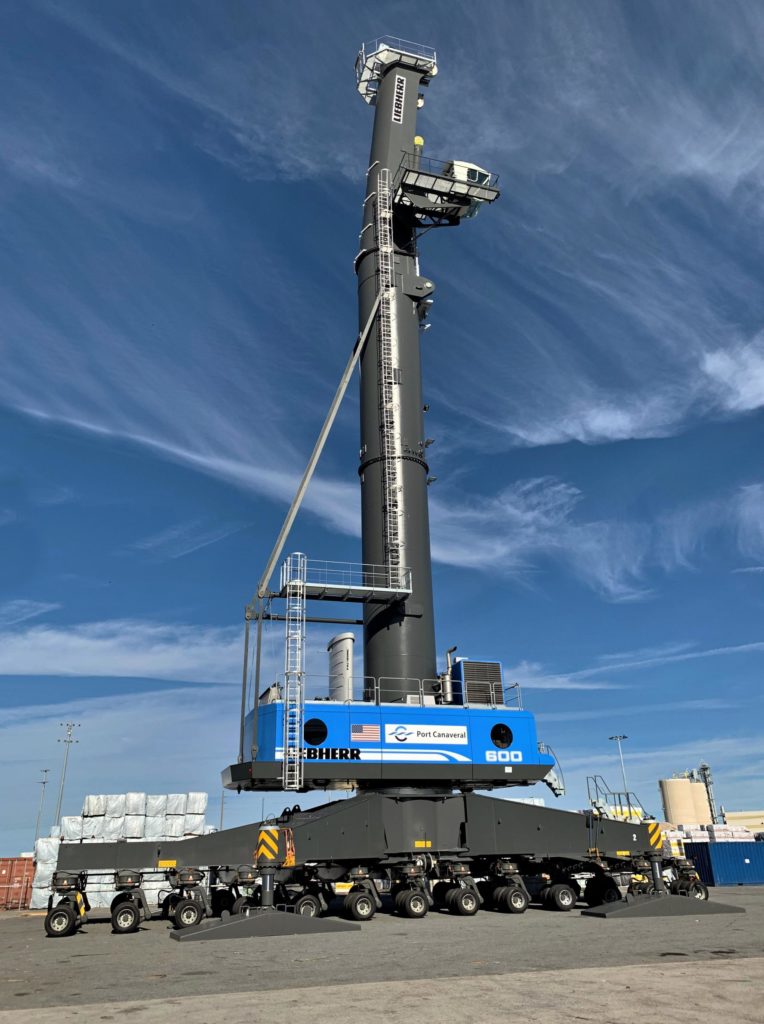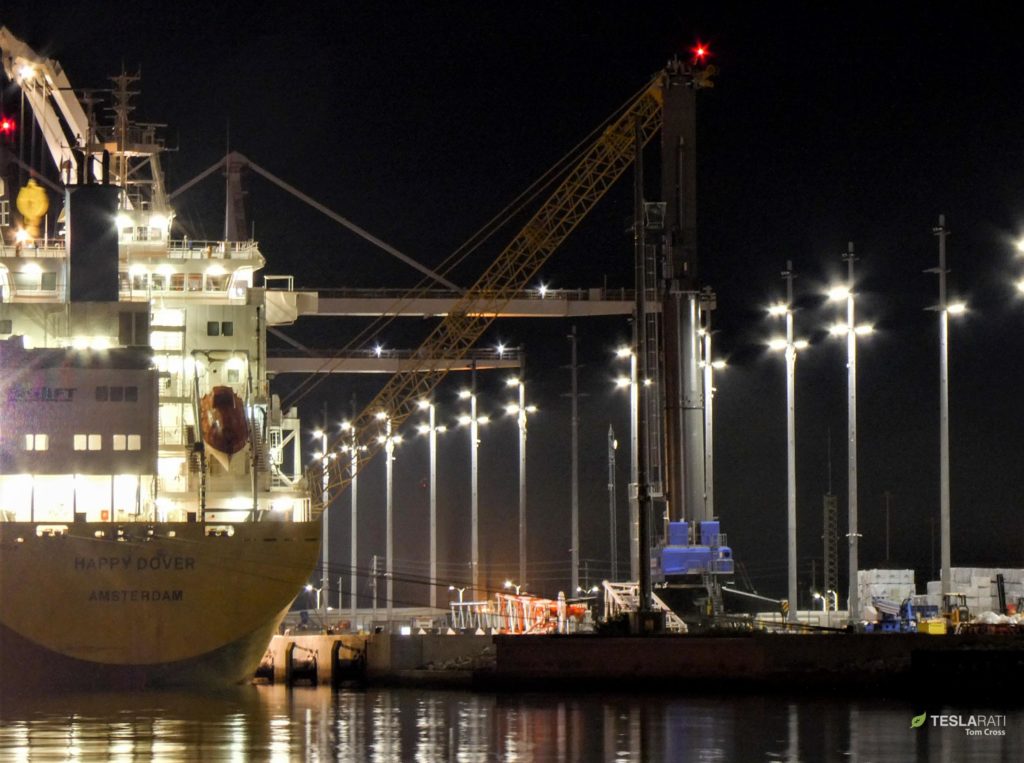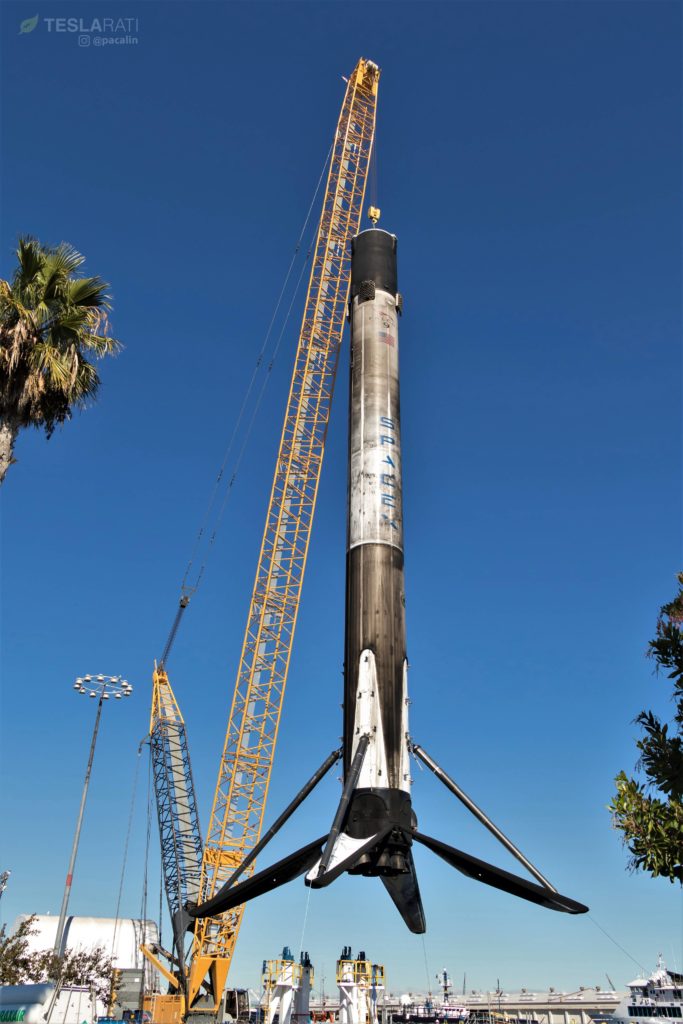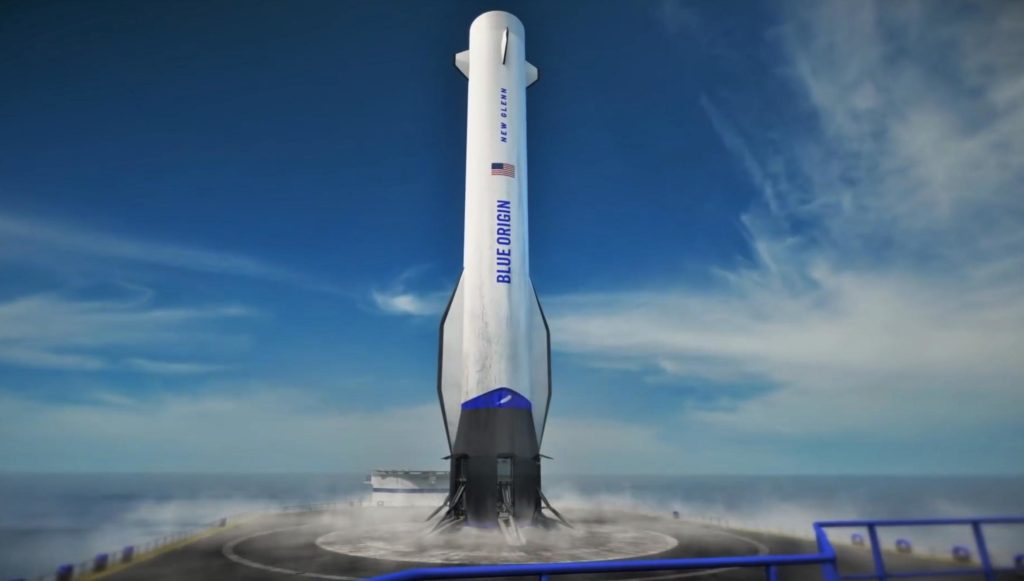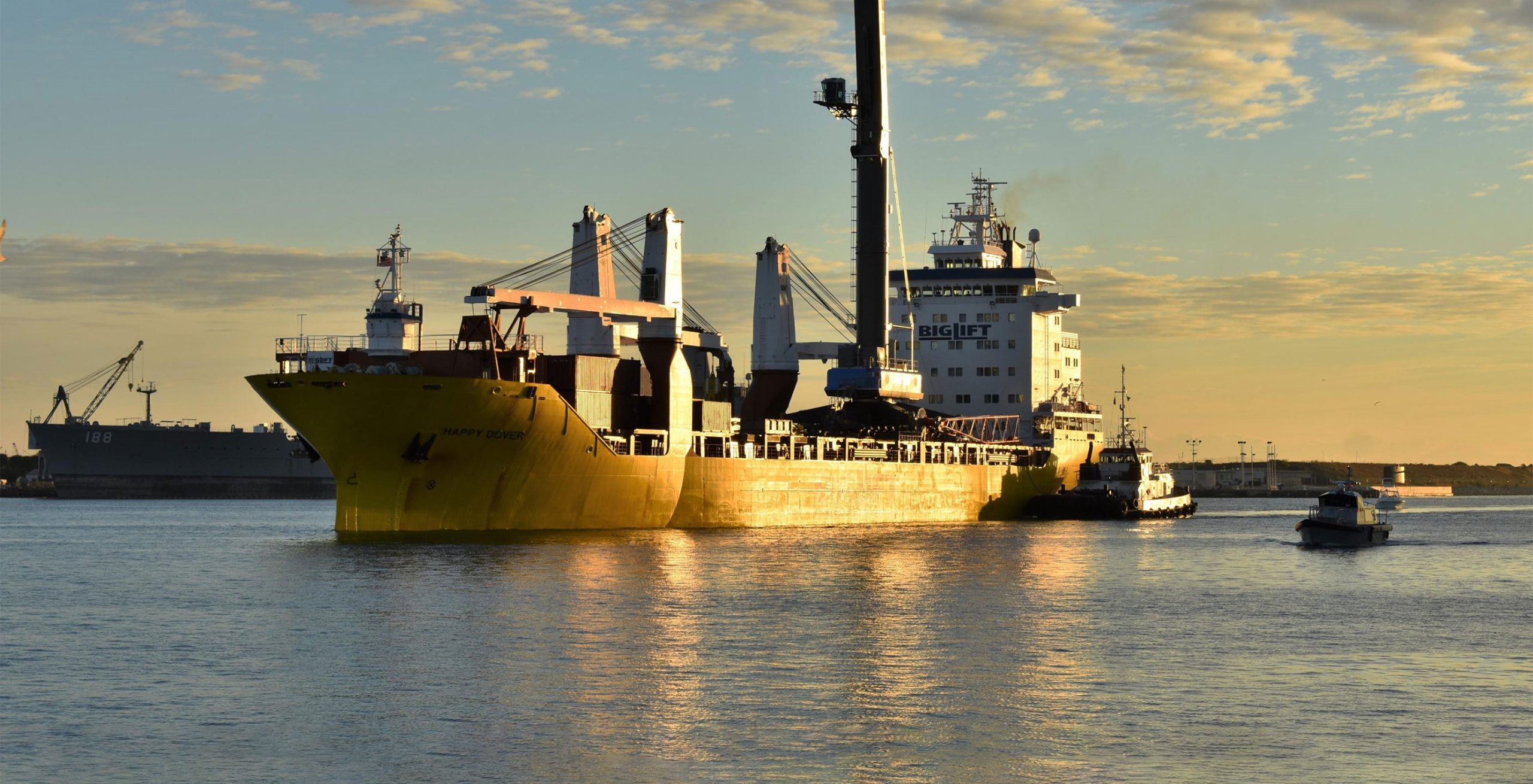
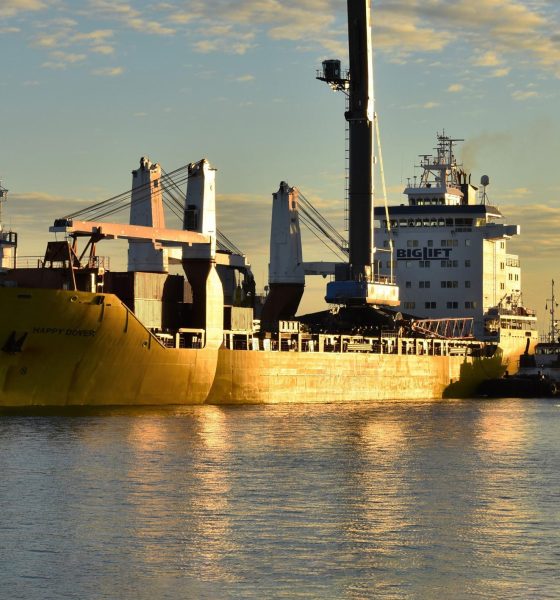
News
Future SpaceX & Blue Origin rocket recoveries may use largest mobile crane in the US
Florida’s Canaveral Port Authority took delivery of what is now the largest mobile crane on U.S. soil, originally purchased in order to support both extremely large cargo ships (known as New-Panamax-class) and the unique needs of orbital-class rocket recovery operations for SpaceX’s Falcon 9 and Falcon Heavy and Blue Origin’s prospective New Glenn launch vehicle.
While there’s a good chance that SpaceX will avoid changing their current Port Canaveral recovery operations and the complement of cranes they already lease or own, Blue Origin will almost certainly take advantage of Port Canaveral’s vast new crane, capable of lifting more than 200 metric tons (~450,000 lbs) at heights greater than 50 meters (160 ft).
I know @AstroVicnet had some questions about the new mobile crane and how it will be used in Port Canaveral. Here is an explainer and how it connects to our Spaceport partners like @SpaceX and @blueorigin. #SpaceXFleet https://t.co/UQqItZbdIr
— Julia Bergeron (@julia_bergeron) January 19, 2019
To put the scale of the crane (and perhaps SpaceX and Blue Origin rockets) into perspective, Falcon 9’s booster – on its own – stands an incredibly 45m (~150 ft) tall or almost the same height as the LHM 600’s main boom (the gray cylinder/tower in the photos above), while Blue Origin’s New Glenn first stage – set to debut as early as 2021 – would tower an extraordinary 57.5m (~190 ft) tall, probably 60m if its small legs are deployed. While SpaceX’s BFR booster (now Super Heavy) is expected to attempt recoveries on the actual launch pad mount, it would stand around 63m (~210 ft) tall. New Glenn and Super Heavy are likely to weigh 50-150+ tons empty.
COLOSSAL CRANE ARRIVES: A 270-foot-tall mobile harbor crane billed as the largest in the United States sails into Port Canaveral aboard the cargo vessel Happy Dover on Friday morning. The 87-foot-long, 1.1-million-pound Liebherr LHM 600 is set to go into service later this year. pic.twitter.com/51DP8Hdb0w
— Port Canaveral (@PortCanaveral) January 18, 2019
The point is that for monolithic objects that are as tall as large rocket boosters, the logistics of actually moving them around can be surprisingly complex and challenging. SpaceX’s Falcon 9 and Heavy boosters happen to be short enough to be conveniently moved and manipulated by cranes that are quite large but still fairly common and easy enough to lease or purchase. SpaceX consistently uses similar tall, yellow cranes for the process of actually lifting Falcon 9 boosters – around 30t (~66,000 lbs) dry – off of their drone ships and onto land, while far smaller wheeled cranes can be used for the process of manipulating Falcon boosters once they are horizontal.
Given just how relatively light Falcon boosters are compared to their towering height, the cranes that can safely lift such tall and delicate objects tend to be designed to easily lift 5-10X as much weight at once. The next-generation rocket boosters (and even SpaceX’s Starship upper stage) will continue to push the height performance and begin to test the mass capabilities of modern cranes, particularly mobile varieties like the one that just arrived in Port Canaveral. One massive benefit of wheeled cranes like LHM 600 is how versatile and flexible they are, while tracked cranes like the largest ones SpaceX currently uses simply can’t move without risking the destruction of the ground beneath them, requiring that they use advanced mass-spreading technologies (i.e. giant beams of hardwood) wherever they crawl.
- Another view of Port Canaveral’s shiny new LHM 600 crane shortly after arriving ashore. (Canaveral Port Authority)
- Teslarati photographer Tom Cross managed to catch Port Canaveral’s new crane shortly after sunset, January 18th. (Tom Cross)
- One of several large cranes used by SpaceX to vertically transport Falcon 9 and Falcon Heavy boosters is pictured here during third recovery of Falcon 9 B1046, December 2018. (Pauline Acalin)
- New Glenn is a massive reusable rocket that will stand ~82m (270 ft) tall and be able to launch up to 45 metric tons (100,000 lb) to low Earth orbit (LEO). (Blue Origin)
Liebherr’s mobile harbor cranes offer a far more mobile solution in the form of traditional rubber tires and multiple large spreader plates that can be deployed and retracted when stationary. It will be genuinely interesting to see if SpaceX decides to replace its proven modes of vertical-lift recovery operations to gain the benefits of a crane that is new and an unknown quantity but could still simplify certain recovery operations. Perhaps even more importantly, the Canaveral Port Authority owns the new crane and apparently bought it with the specific intention of allowing companies like SpaceX and Blue Origin to use it – presumably for a reasonable fee – to assist during rocket recovery operations.

News
Tesla removes Safety Monitors, begins fully autonomous Robotaxi testing
This development, in terms of the Robotaxi program, is massive. Tesla has been working incredibly hard to expand its fleet of Robotaxi vehicles to accommodate the considerable demand it has experienced for the platform.
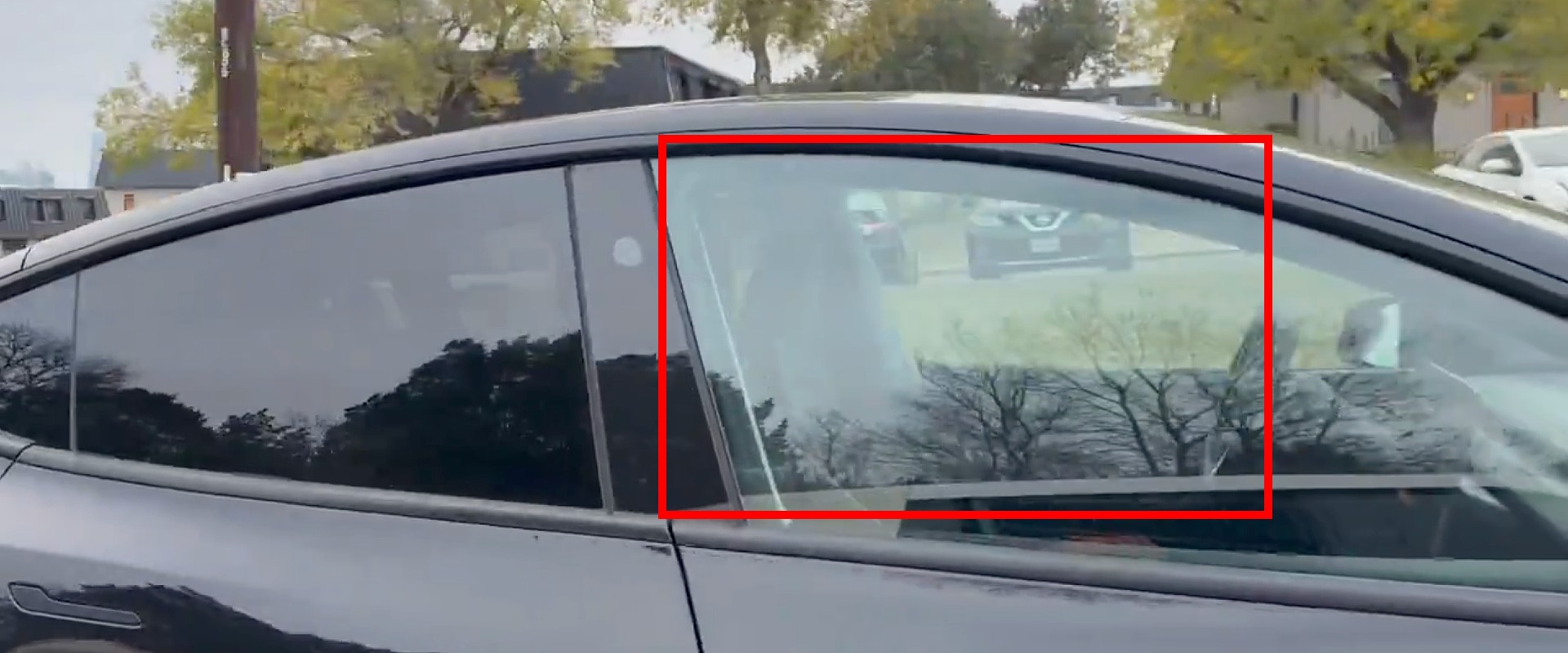
Tesla has started Robotaxi testing in Austin, Texas, without any vehicle occupants, the company’s CEO Elon Musk confirmed on Sunday. Two Tesla Model Y Robotaxi units were spotted in Austin traveling on public roads with nobody in the car.
The testing phase begins just a week after Musk confirmed that Tesla would be removing Safety Monitors from its vehicles “within the next three weeks.” Tesla has been working to initiate driverless rides by the end of the year since the Robotaxi fleet was launched back in June.
Two units were spotted, with the first being seen from the side and clearly showing no human beings inside the cabin of the Model Y Robotaxi:
A Tesla without a driver was spotted traveling on public roads! pic.twitter.com/ZLbduf4cKa
— TESLARATI (@Teslarati) December 14, 2025
Another unit, which is the same color but was confirmed as a different vehicle, was spotted just a few moments later:
NEWS: A second Tesla Model Y Robotaxi running FSD Unsupervised has just been spotted driving itself on public roads in Austin, Texas, with no one in the front seats.
This is a different car from the one spotted earlier. They have different license plates.
h/t @Mandablorian https://t.co/5URYsUGyD0 pic.twitter.com/CIUi4mXi33
— Sawyer Merritt (@SawyerMerritt) December 14, 2025
The two units are traveling in the general vicinity of the South Congress and Dawson neighborhoods of downtown Austin. These are located on the southside of the city.
This development, in terms of the Robotaxi program, is massive. Tesla has been working incredibly hard to expand its fleet of Robotaxi vehicles to accommodate the considerable demand it has experienced for the platform.
However, the main focus of the Robotaxi program since its launch in the Summer was to remove Safety Monitors and initiate completely driverless rides. This effort is close to becoming a reality, and the efforts of the company are coming to fruition.
Testing is underway with no occupants in the car
— Elon Musk (@elonmusk) December 14, 2025
It is a drastic step in the company’s trek for self-driving technology, as it plans to expand it to passenger vehicles in the coming years. Tesla owners have plenty of experience with the Full Self-Driving suite, which is not fully autonomous, but is consistently ranked among the best-performing platforms in the world.
News
Tesla refines Full Self-Driving, latest update impresses where it last came up short
We were able to go out and test it pretty extensively on Saturday, and the changes Tesla made from the previous version were incredibly impressive, especially considering it seemed to excel where it last came up short.

Tesla released Full Self-Driving v14.2.1.25 on Friday night to Early Access Program (EAP) members. It came as a surprise, as it was paired with the release of the Holiday Update.
We were able to go out and test it pretty extensively on Saturday, and the changes Tesla made from the previous version were incredibly impressive, especially considering it seemed to excel where it last came up short.
Tesla supplements Holiday Update by sneaking in new Full Self-Driving version
With Tesla Full Self-Driving v14.2.1, there were some serious regressions. Speed Profiles were overtinkered with, causing some modes to behave in a strange manner. Hurry Mode was the most evident, as it refused to go more than 10 MPH over the speed limit on freeways.
It would routinely hold up traffic at this speed, and flipping it into Mad Max mode was sort of over the top. Hurry is what I use most frequently, and it had become somewhat unusable with v14.2.1.
It seemed as if Speed Profiles should be more associated with both passing and lane-changing frequency. Capping speeds does not help as it can impede the flow of traffic. When FSD travels at the speed of other traffic, it is much more effective and less disruptive.
With v14.2.1.25, there were three noticeable changes that improved its performance significantly: Speed Profile refinements, lane change confidence, and Speed Limit recognition.
🚨 Many of you asked us to test highway driving with Tesla Full Self-Driving v14.2.1.25. Here’s what we noticed:
✅ Speed Profiles are significantly improved. Hurry Mode is no longer capped at 10 MPH over the speed limit, and now travels with the flow of traffic. This is much… pic.twitter.com/48ZCGbW0JO
— TESLARATI (@Teslarati) December 13, 2025
Speed Profile Refinement
Speed Profiles have been significantly improved. Hurry Mode is no longer capped at 10 MPH over the speed limit and now travels with the flow of traffic. This is much more comfortable during highway operation, and I was not required to intervene at any point.
With v14.2.1, I was sometimes assisting it with lane changes, and felt it was in the wrong place at the wrong time more frequently than ever before.
However, this was one of the best-performing FSD versions in recent memory, and I really did not have any complaints on the highway. Speed, maneuvering, lane switching, routing, and aggressiveness were all perfect.
Lane Changes
v14.2.1 had a tendency to be a little more timid when changing lanes, which was sort of frustrating at times. When the car decides to change lanes and turn on its signal, it needs to pull the trigger and change lanes.
It also changed lanes at extremely unnecessary times, which was a real frustration.
There were no issues today on v14.2.1.25; lane changes were super confident, executed at the correct time, and in the correct fashion. It made good decisions on when to get into the right lane when proceeding toward its exit.
It was one of the first times in a while that I did not feel as if I needed to nudge it to change lanes. I was very impressed.
Speed Limit Recognition
So, this is a complex issue. With v14.2.1, there were many times when it would see a Speed Limit sign that was not meant for the car (one catered for tractor trailers, for example) or even a route sign, and it would incorrectly adjust the speed. It did this on the highway several times, mistaking a Route 30 sign for a 30 MPH sign, then beginning to decelerate from 55 MPH to 30 MPH on the highway.
This required an intervention. I also had an issue leaving a drive-thru Christmas lights display, where the owners of the private property had a 15 MPH sign posted nearly every 200 yards for about a mile and a half.
The car identified it as a 55 MPH sign and sped up significantly. This caused an intervention, and I had to drive manually.
It seems like FSD v14.2.1.25 is now less reliant on the signage (maybe because it was incorrectly labeling it) and more reliant on map data or the behavior of nearby traffic.
A good example was on the highway today: despite the car reading that Route 30 sign and the Speed Limit sign on the center screen reading 30 MPH, the car did not decelerate. It continued at the same speed, but I’m not sure if that’s because of traffic or map data:
🚨 We listened to and read a lot of you who had a complaint of Tesla Full Self-Driving v14.2.1 incorrectly reading Speed Limit signs
This appears to be resolved in v14.2.1.25.
Here’s a breakdown: pic.twitter.com/TEP03xrMbt
— TESLARATI (@Teslarati) December 13, 2025
A Lone Complaint
Tesla has said future updates will include parking improvements, and I’m really anxious for them, because parking is not great. I’ve had some real issues with it over the past couple of months.
Today was no different:
🚨 My lone complaint with my drive on Tesla FSD v14.2.1.25 was this strange parking instance.
FSD swung out wide to the left to pull into this spot and this is where it seemed to be stumped. I gave it about 10 seconds after the car just stopped moving for it to make some… https://t.co/ZEkhTHOihG pic.twitter.com/TRemXu5DLf
— TESLARATI (@Teslarati) December 13, 2025
Full Self-Driving v14.2.1.25 is really a massive improvement over past versions, and it seems apparent that Tesla took its time with fixing the bugs, especially with highway operation on v14.2.1.
News
Tesla hints at Starlink integration with recent patent
“By employing polymer blends, some examples enable RF transmission from all the modules to satellites and other communication devices both inside and outside the vehicle.”

Tesla hinted at a potential Starlink internet terminal integration within its vehicles in a recent patent, which describes a vehicle roof assembly with integrated radio frequency (RF) transparency.
The patent, which is Pub. No U.S. 2025/0368267 describes a new vehicle roof that is made of RF-transparent polymer materials, allowing and “facilitating clear communication with external devices and satellites.”
Tesla believes that a new vehicle roof design, comprised of different materials than the standard metallic or glass elements used in cars today, would allow the company to integrate modern vehicular technologies, “particularly those requiring radio frequency transmission and reception.
Tesla has recently filed a US patent application on integrating RF transparent materials into the roof structure.
“facilitating clear communication with external devices and satellites”
Tesla fleet is getting @Starlink connectivity integration soon. LFG @Tesla @elonmusk… pic.twitter.com/bLa8YtPLd1
— Chansoo Byeon (@Chansoo) December 9, 2025
Instead of glass or metallic materials, Tesla says vehicles may benefit from high-strength polymer blends, such as Polycarbonate, Acrylonitrile Butadiene Styrene, or Acrylonitrile Styrene Acrylate.
These materials still provide ideal strength metrics for crashworthiness, stiffness for noise, vibration, and harshness control, and are compliant with head impact regulations.
They would also enable better performance with modern technologies, like internet terminals, which need an uninterrupted signal to satellites for maximum reception. Tesla writes in the patent:
“By employing polymer blends, some examples enable RF transmission from all the modules to satellites and other communication devices both inside and outside the vehicle.”

One of the challenges Tesla seems to be aware of with this type of roof design is the fact that it will still have to enable safety and keep that at the forefront of the design. As you can see in the illustration above, Tesla plans to use four layers to increase safety and rigidity, while also combating noise and vibration.
It notes in the patent that disclosed examples still meet the safety requirements outlined in the Federal Motor Vehicle Safety Standards (FMVSS).
Starlink integrated directly into Tesla vehicles would be a considerable advantage for owners. It would come with a handful of distinct advantages.
Initially, the inclusion of Starlink would completely eliminate cellular dead zones, something that is an issue, especially in rural areas. Starlink would provide connectivity in these remote regions and would ensure uninterrupted service during road trips and off-grid adventures.
It could also be a critical addition for Robotaxi, as it is crucial to have solid and reliable connectivity for remote monitoring and fleet management.
Starlink’s growing constellation, thanks to SpaceX’s routine and frequent launch schedule, will provide secure, stable, and reliable internet connectivity for Tesla vehicles.
Although many owners have already mounted Starlink Mini dishes under their glass roofs for a similar experience, it may be integrated directly into Teslas in the coming years, either as an upgrade or a standard feature.
